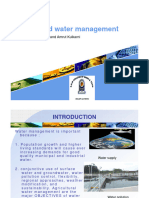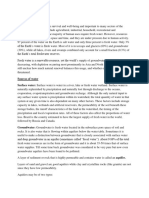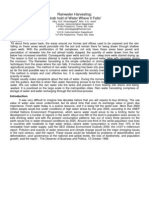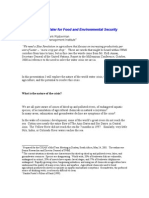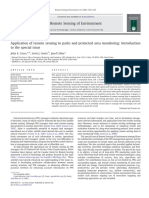Why Do We Need Dams
Why Do We Need Dams
Uploaded by
pashish77Copyright:
Available Formats
Why Do We Need Dams
Why Do We Need Dams
Uploaded by
pashish77Original Description:
Original Title
Copyright
Available Formats
Share this document
Did you find this document useful?
Is this content inappropriate?
Copyright:
Available Formats
Why Do We Need Dams
Why Do We Need Dams
Uploaded by
pashish77Copyright:
Available Formats
Why do we need dams ? In ancient times, dams were built for the single purpose of water supply or irrigation.
As civilizations developed, there was a greater need for water supply, irrigation, flood control, navigation, water quality, sediment control and energy. Therefore, dams are constructed for a specific purpose such as water supply, flood control, irrigation, navigation, sedimentation control, and hydropower. A dam is the cornerstone in the development and management of water resources development of a river basin. The multipurpose dam is a very important project for developing countries, because the population receives domestic and economic benefits from a single investment.
Inscriptions in the sluice of the Marib dam, built in 750 BC
Demand for water is steadily increasing throughout the world. There is no life on earth without water, our most important resource apart from air and land. During the past three centuries, the amount of water withdrawn from freshwater resources has increased by a factor of 35, world population by a factor of 8. With the present world population of 5.6 billion still growing at a rate of about 90 million per year, and with their legitimate expectations of higher standards of living, global water demand is expected to rise by a further 2-3 percent annually in the decades ahead. But freshwater resources are limited and unevenly distributed. In the highconsumption countries with rich resources and a highly developed technical infrastructure, the many ways of conserving, recycling and re-using water may more or less suffice to curb further growth in supply. In many other regions, however, water availability is critical to any further development above the present unsatisfactorily low level, and even to the mere survival of existing communities or to meet the continuously growing demand originating from the rapid increase of their population. In these regions man cannot forego the contribution to be made by dams and reservoirs to the harnessing of water resources.
Seasonal variations and climatic irregularities in flow impede the efficient use of river runoff, with flooding and drought causing problems of catastrophic proportions. For almost 5 000 years dams have served to ensure an adequate supply of water by storing water in times of surplus and releasing it in times of scarcity, thus also preventing or mitigating floods With their present aggregate storage capacity of about 6 000 km3, dams clearly make a significant contribution to the
efficient management of finite water resources that are unevenly distributed and subject to large seasonal fluctuations. The purposes of dams Most of the dams are single-purpose dams, but there is now a growing number of multipurpose dams. Using the most recent publication of the World Register of Dams, irrigation is by far the most common purpose of dams. Among the single purpose dams, 48 % are for irrigation, 17% for hydropower (production of electricity), 13% for water supply , 10% for flood control, 5% for recreation and less than 1% for navigation and fish farming. Irrigation: Presently, irrigated land covers about 277 million hectares i.e. about 18% of world's arable land but is responsible for around 40% of crop output and employs nearly 30% of population spread over rural areas. With the large population growth expected for the next decades, irrigation must be expanded to increase the food capacity production. It is estimated that 80% of additional food production by the year 2025 will need to come from irrigated land. Even with the widespread measures to conserve water by improvements in irrigation technology, the construction of more reservoir projects will be required.
"Food grows where water flows"
Hydropower: Hydroelectric power plants generally range in size from several hundred kilowatts to several hundred megawatts, but a few Generators in enormous plants have capacities near 10,000 megawatts in order to the power supply electricity to millions of people. World hydroelectric power plant plants have a combined capacity of 675,000 megawatts that produces over 2.3 trillion kilowatt-hours of electricity each year; supplying 24 percent of the world's electricity. In many countries, hydroelectric power provides nearly all of the electrical power. In 1998, the hydroelectric plants of Norway and the Democratic Republic of the Congo (formerly Zaire) provided 99 percent of each country's power; and hydroelectric plants in Brazil provided 91 percent of total used electricity. Electricity generated from dams is by very far the largest renewable energy source in the world. More than 90% of the world's renewable electricity comes from dams. Hydropower also offers unique possibilities to manage the power network by its ability to quickly respond to peak demands. Pumping-storage plants, using power produced during the night, while the demand is low, is used to pump water up to the higher reservoir. That water is then used during the peak
demand period to produce electricity. This system today constitute the only economic mass storage available for electricity. Water supply for domestic and industrial use: It has been stressed how essential water is for our civilization. It is important to remember that of the total rainfall falling on the earth, most falls on the sea and a large portion of that which falls on earth ends up as runoff. Only 2% of the total is infiltrated to replenish the groundwater. Properly planned, designed and constructed and maintained dams to store water contribute significantly toward fulfilling our water supply requirements. To accommodate the variations in the hydrologic cycle, dams and reservoirs are needed to store water and then provide more consistent supplies during shortages.
Industry facilities like this power plant need million of litters per day. A city like Mumbai in India (16 million inhabitants) need 4300 millions of litters per day (lpd) Melbourne in Australia (4million inhabitants) needs around 1000 millions lpd and Paris in France needs some 700 millions lpd. In each of thes examples, water would not be provided without dams.
Inland navigation Natural river conditions, such as changes in the flow rate and river level, ice and changing river channels due to erosion and sedimentation, create major problems and obstacles for inland navigation. The advantages of inland navigation, however, when compared with highway and rail are the large load carrying capacity of each barge, the ability to handle cargo with large-dimensions and fuel savings. Enhanced inland navigation is a result of comprehensive basin planning and development utilizing dams, locks and reservoirs which are regulated to provide a vital role in realizing regional and national economic benefits. In addition to
Large shipment of goods move the locks and dams on inland waterways, such as this tow, on the lower part of the picture.
the economic benefits, a river that has been developed with dams and reservoirs for navigation may also provide additional benefits of flood control, reduced erosion, stabilized groundwater levels throughout the system and recreation. Flood control
Floods can cause major damage to humans lives, property, and livestocks. Cities and towns have been devastated due to flood damage. Lives have bees lost and homes destoyed. Flooding can cause epidemics due to sewer disposal and contamined water supplies. Dams can play a role in limiting the extent of flood damages
Dams and reservoirs can be effectively used to regulate river levels and flooding downstream of the dam by temporarily storing the flood volume and releasing it later. The most effective method of flood control is accomplished by an integrated water management plan for regulating the storage and discharges of each of the main dams located in a river basin. Each dam is operated by a specific water control plan for routing floods through the basin without damage. This means lowering of the reservoir level to create more storage before the rainy season. This strategy eliminates flooding. The number of dams and their water control management plans are established by comprehensive planning for economic development and with public involvement. Flood control is a significant purpose for many of the existing dams and continues as a main purpose for some of the major dams of the world currently under construction.
You might also like
- Plastic Bag Franklin AssociatesDocument173 pagesPlastic Bag Franklin AssociatesMikaila Denise LoanzonNo ratings yet
- Benefits of and Concerns About DamsDocument10 pagesBenefits of and Concerns About Damsمحمد فكريNo ratings yet
- National Institute of Technology Uttarakhand 2014-15: Report On Imapcts of DamsDocument10 pagesNational Institute of Technology Uttarakhand 2014-15: Report On Imapcts of DamsRohit BansalaNo ratings yet
- Rainwater Harvesting-A Study - by Gangu R KeswaniDocument30 pagesRainwater Harvesting-A Study - by Gangu R KeswaniGangu Keswani100% (1)
- Assignment2 SahipaDocument6 pagesAssignment2 SahipaNadzrin SahipaNo ratings yet
- 3 Water ResourcesDocument11 pages3 Water Resourcessmak11No ratings yet
- Conferences: Defining Water Management For The 1980sDocument3 pagesConferences: Defining Water Management For The 1980sManticora VenerabilisNo ratings yet
- Integrated Water ManagementDocument16 pagesIntegrated Water Managementadit.shet23100% (1)
- © Ncert Not To Be Republished: Water: Some Facts and FiguresDocument11 pages© Ncert Not To Be Republished: Water: Some Facts and FiguresArijit PanigrahyNo ratings yet
- ©ncert Not To Be Republished: Water: Some Facts and FiguresDocument11 pages©ncert Not To Be Republished: Water: Some Facts and FiguresShreya SharmaNo ratings yet
- Bài Đọc 4.2Document3 pagesBài Đọc 4.2thaihayeudau2003No ratings yet
- Dam and Their Role: Sub By-Jay Suman 6Th Sem CUJ1/1/2012/IMBA/8Document16 pagesDam and Their Role: Sub By-Jay Suman 6Th Sem CUJ1/1/2012/IMBA/8Bhaskar BhushanNo ratings yet
- Feasibility Study of Application of Residential Rainwater Harvesting: A Water-Energy Nexus ApproachDocument5 pagesFeasibility Study of Application of Residential Rainwater Harvesting: A Water-Energy Nexus ApproachSujan MaharjanNo ratings yet
- Water Resources: Dr. H.S. RameshDocument5 pagesWater Resources: Dr. H.S. RameshPraful KakdeNo ratings yet
- Dam and Other Water Control Structures: Good or Evil?Document8 pagesDam and Other Water Control Structures: Good or Evil?aabhash bhattaraiNo ratings yet
- Unit 3 - II - Water ResourcesDocument7 pagesUnit 3 - II - Water Resourcespalak662005No ratings yet
- Water Resources Prashant KiradDocument14 pagesWater Resources Prashant Kiradst387816No ratings yet
- Water Resources (Prashant Kirad)Document14 pagesWater Resources (Prashant Kirad)ramindersingh0008No ratings yet
- CH - 3 - WATER ResourcesDocument12 pagesCH - 3 - WATER ResourcesbookobsessedforeverNo ratings yet
- Water Crisis in PakistanDocument4 pagesWater Crisis in PakistanFizaNo ratings yet
- Water Resources (Prashant Kirad)Document14 pagesWater Resources (Prashant Kirad)shrikantmisal1797% (31)
- Role of Geopurification in Future Water ManagementDocument9 pagesRole of Geopurification in Future Water Managementivan.e.parraNo ratings yet
- Project Water Dectector2-1gDocument22 pagesProject Water Dectector2-1grobertjeff313No ratings yet
- Trends in Water Resources Development Projects in NigeriaDocument7 pagesTrends in Water Resources Development Projects in NigeriaRaji De Cypress OladapoNo ratings yet
- Economic and Political Weekly Economic and Political WeeklyDocument9 pagesEconomic and Political Weekly Economic and Political WeeklyBrijeshNo ratings yet
- Water Resources NotesDocument6 pagesWater Resources NotesSaanvi JaiswalNo ratings yet
- Water Resources Class 10 Learn With MadhuDocument42 pagesWater Resources Class 10 Learn With Madhuamritadevi121979No ratings yet
- Jess 103Document11 pagesJess 103Priti FalkeNo ratings yet
- Water ResourcesDocument14 pagesWater ResourcesFadilaNo ratings yet
- Water Resources Question and Answers Class 10Document6 pagesWater Resources Question and Answers Class 10santushtnirankari49No ratings yet
- Geography 3. Water ResourcesDocument11 pagesGeography 3. Water ResourcessanfordlaxmipurNo ratings yet
- Rainwater Harvesting: Grab Hold of Water Where It Falls!: Mrs. S.D. Khandagale, Mrs. V.A. JoshiDocument9 pagesRainwater Harvesting: Grab Hold of Water Where It Falls!: Mrs. S.D. Khandagale, Mrs. V.A. JoshiAnkita BahetiNo ratings yet
- Exercises-Answer Key: Chapter 3 - Water ResourcesDocument5 pagesExercises-Answer Key: Chapter 3 - Water Resourcespriyaseshadri5100% (1)
- Unit3 WaterDocument4 pagesUnit3 Wateraditya dev TyagiNo ratings yet
- CH - 1 PDFDocument7 pagesCH - 1 PDFhailishNo ratings yet
- Water CrisisDocument8 pagesWater CrisisAbdul BasitNo ratings yet
- Different Sources of Water: DescriptionDocument4 pagesDifferent Sources of Water: DescriptionRichard Yves UbongenNo ratings yet
- RAINWATER: A Valuable Water Resource - Neglected or Utilized?Document13 pagesRAINWATER: A Valuable Water Resource - Neglected or Utilized?NadineNo ratings yet
- Water Resources Prashant KiradDocument9 pagesWater Resources Prashant Kiradanilbasat0062No ratings yet
- Dams & The World's WaterDocument82 pagesDams & The World's WatergoranpaNo ratings yet
- Catchment ManagementDocument4 pagesCatchment ManagementSachitha RajanNo ratings yet
- Essay: TOPIC:-Water Resource Utilisation and Irrigation Development in IndiaDocument9 pagesEssay: TOPIC:-Water Resource Utilisation and Irrigation Development in IndiaSumit SinghNo ratings yet
- Water Scarcity-1Document12 pagesWater Scarcity-1Yug PatelNo ratings yet
- Problems Associated With Philippine Clean Water Act of 2004Document84 pagesProblems Associated With Philippine Clean Water Act of 2004NICO OBEJERONo ratings yet
- Reading - 6 Questions - Sat 2705Document3 pagesReading - 6 Questions - Sat 2705Linh Trần Hà KhánhNo ratings yet
- GeographyDocument11 pagesGeographySohil SharmaNo ratings yet
- Assuring Water For Food and Environmental SecurityDocument11 pagesAssuring Water For Food and Environmental SecurityMian Usman UsmanNo ratings yet
- Water Management System in PakistanDocument6 pagesWater Management System in PakistanWajiha Asad KiyaniNo ratings yet
- How Much Water Is Available On Earth and How Much of This Water Is Available For Humans?Document4 pagesHow Much Water Is Available On Earth and How Much of This Water Is Available For Humans?Vel MuruganNo ratings yet
- CHJBKDocument12 pagesCHJBKbabitasegar244No ratings yet
- Water Crisis SynopsisDocument11 pagesWater Crisis SynopsisVikash PeerthyNo ratings yet
- NCERT 23feb Solutions Class 10 Social Science Geography Chapter 3 Water ResourcesDocument4 pagesNCERT 23feb Solutions Class 10 Social Science Geography Chapter 3 Water Resourcessarvesh kumarNo ratings yet
- Water ConservationDocument6 pagesWater ConservationShubam SharmaNo ratings yet
- Interlinking of Rivers: Presented ByDocument24 pagesInterlinking of Rivers: Presented ByAbhishek KhametraNo ratings yet
- Ce 2031 Water Resources EngineeringDocument30 pagesCe 2031 Water Resources EngineeringManikandan.R.KNo ratings yet
- Water Wastewater Purification and ReuseDocument12 pagesWater Wastewater Purification and Reusemohammed aljubairiNo ratings yet
- Itro DessalementDocument4 pagesItro DessalementAchraf SOUNNINo ratings yet
- The Global Water Crisis - Solutions for a Thirsty PlanetFrom EverandThe Global Water Crisis - Solutions for a Thirsty PlanetNo ratings yet
- AdvertisingDocument31 pagesAdvertisingpashish77100% (1)
- Amul ReportDocument74 pagesAmul Reportpashish77100% (1)
- S S: M V B S: Upporting Uccess Ission Alues Eliefs TandardsDocument4 pagesS S: M V B S: Upporting Uccess Ission Alues Eliefs Tandardspashish77No ratings yet
- MGMT LectureNotes Chap1Document8 pagesMGMT LectureNotes Chap1pashish77No ratings yet
- An Overview of Customer Relationship ManagementDocument4 pagesAn Overview of Customer Relationship Managementpashish77No ratings yet
- Foundation of Group BehaviorDocument34 pagesFoundation of Group Behaviorpashish77No ratings yet
- Partial Differential EquationsDocument44 pagesPartial Differential Equationspashish77No ratings yet
- Septic Tank DetailDocument1 pageSeptic Tank DetailJonniel De Guzman100% (3)
- Water Cycle Webquest Student Capture SheetDocument5 pagesWater Cycle Webquest Student Capture Sheetapi-268569185No ratings yet
- My Dream City FARIDABADDocument3 pagesMy Dream City FARIDABADShruti ThakkarNo ratings yet
- Ralph C. Whitley SR.: From: Sent: To: CCDocument2 pagesRalph C. Whitley SR.: From: Sent: To: CCRalph Charles Whitley, Sr.No ratings yet
- Effluent Treatment PlantDocument16 pagesEffluent Treatment PlantVishal guptaNo ratings yet
- GYCC - Implementation Plan For The Climate Dialogue For Global Youth - Revised PDFDocument4 pagesGYCC - Implementation Plan For The Climate Dialogue For Global Youth - Revised PDFPaudel NigamNo ratings yet
- Remote Sensing For EnvironmentDocument3 pagesRemote Sensing For EnvironmentWira WiryadiNo ratings yet
- Engine Rating To Junior Engineer Promotion ChecklistDocument3 pagesEngine Rating To Junior Engineer Promotion ChecklistBraulio CvNo ratings yet
- 1 IntroductionDocument36 pages1 IntroductionDennis LingNo ratings yet
- Bulletin 39 Fuel Hydrant Commissioning Jan 2011Document3 pagesBulletin 39 Fuel Hydrant Commissioning Jan 2011azizNo ratings yet
- LD-P2M2 (MAIN) - EIA As Source of Power To Control ESC in Malaysia - 20170919 - TRG PDFDocument162 pagesLD-P2M2 (MAIN) - EIA As Source of Power To Control ESC in Malaysia - 20170919 - TRG PDFJohn ConnorsNo ratings yet
- TMF Lime SofteningDocument2 pagesTMF Lime SofteningRachel HechanovaNo ratings yet
- Municipal Solid WasteDocument15 pagesMunicipal Solid WasteJoseph RugatiriNo ratings yet
- Textile Exchange - Preferred Fiber Materials Market Report - 2017 4 PDFDocument77 pagesTextile Exchange - Preferred Fiber Materials Market Report - 2017 4 PDFIlanchezian SambandamNo ratings yet
- Wind Power PlantDocument36 pagesWind Power PlantAnonymous DMR58iAkP100% (1)
- U7 TestDocument4 pagesU7 TestTrung Thành NguyễnNo ratings yet
- Dharavi ProblemsDocument3 pagesDharavi ProblemscsohiniNo ratings yet
- Romney Announces Strict New Clean Air Regulations To Take Effect January 1Document2 pagesRomney Announces Strict New Clean Air Regulations To Take Effect January 1perrytruthteamNo ratings yet
- Aplicaciones Bomba de LodosDocument6 pagesAplicaciones Bomba de LodosJosueNo ratings yet
- Urban Ecology and Sustainability: by Atif Nauman (University of Gujrat)Document22 pagesUrban Ecology and Sustainability: by Atif Nauman (University of Gujrat)Camlon KhajarNo ratings yet
- Surface Chemistry in The Oil Spill CleanDocument1 pageSurface Chemistry in The Oil Spill CleanlaBoraxNo ratings yet
- Idaho - A Regulatory Guide To Geothermal Direct Use DevelopmentDocument15 pagesIdaho - A Regulatory Guide To Geothermal Direct Use DevelopmentPS20171No ratings yet
- Department of Pesticide RegulationDocument2 pagesDepartment of Pesticide RegulationBruce PerezNo ratings yet
- ISO22628 - Cota de ReciclagemDocument4 pagesISO22628 - Cota de ReciclagemJr BelancieriNo ratings yet
- Tools For Natural Resource Management and MonitroingDocument1 pageTools For Natural Resource Management and MonitroingHealthy Land and WaterNo ratings yet
- EIA Guidance EIA Report Final PDFDocument130 pagesEIA Guidance EIA Report Final PDFKARVENDHAN SNo ratings yet
- SASC-S-18 Public Health Nuisances: With Referenced Documents Listed at The End of This Code SectionDocument4 pagesSASC-S-18 Public Health Nuisances: With Referenced Documents Listed at The End of This Code SectionTarun AggarwalNo ratings yet
- ZDP P-I Report - Approved - 300710Document42 pagesZDP P-I Report - Approved - 300710RájDèép TrìpâţhíNo ratings yet
- Insident ReportDocument2 pagesInsident ReportVisionNo ratings yet







